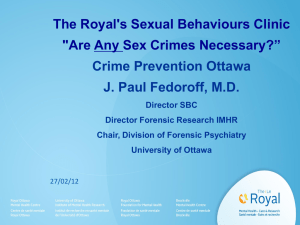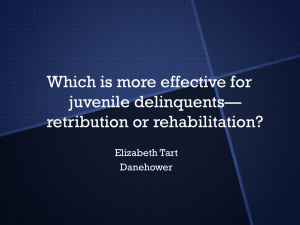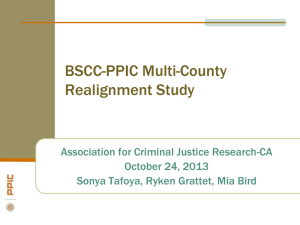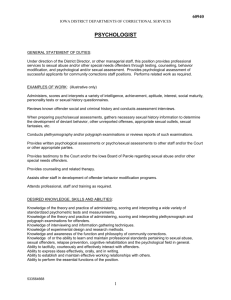2Adolescent Sex Offenders
advertisement
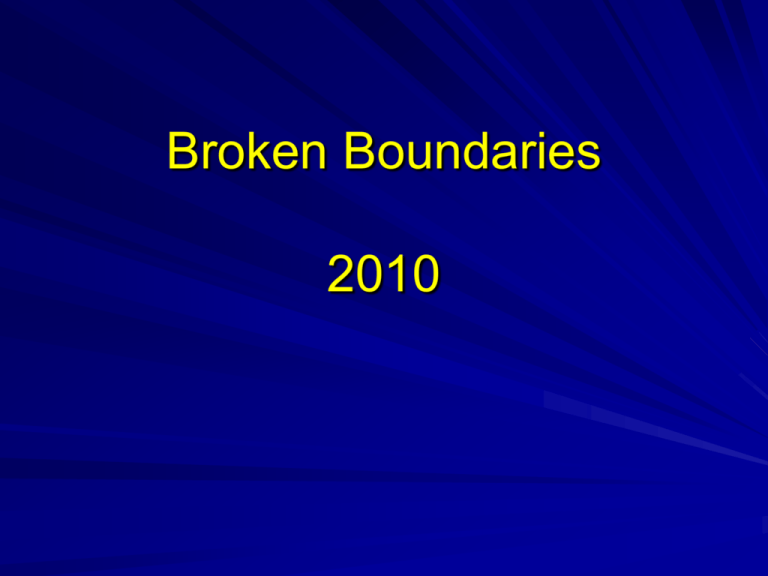
Broken Boundaries 2010 What Do We Know About Adolescent Sex Offenders? Anna C. Salter Adult Sex Offenders & Age of Onset 1/3 to 1/2 began offending In adolescence (Prentky et al., 2000) Juvenile Sex Offenders: Age of Onset Begin Offending Under Age 12 46% (Burton, 2000) Scope of the Problem 1994 Under age 13 Arrested for felonies 110,000 (Berman, Kurtines, Silverman, & Serafini, 1996) Rise and Fall of Juvenile Crime 1983 – 1992 Arrests Girls +85% Boys +50% Youth in juvenile facilities +41% ( Children’s Defense Fund, 1997) Rise of Juvenile Crime 1980 – 1994 Arrests Violent crimes +64% Murder +99% (Butts & Travis, 2002) Fall in Juvenile Violent Crime Fell 6 years 1994 – 2000 (Butts & Travis, 2002) Decline in Juvenile Crime Violent Crime Murder, rape, robbery aggravated assault -34% Decline in Juvenile Crime Arrests 1994 - 2000 Murder Robbery Burglary Rape -68% -51% -33% -25% (Butts & Travis, 2002) Decline in Violent Crime 2000 Lowest in 20 years (Butts & Travis, 2002) Decline in Juvenile Crime Largest of any age group Increases in Juvenile Crime Arrests 1994 – 2000 DUI +54% Liquor Law Violations +33% Drug Abuse +29% (Butts & Travis, 2002) Decline in Crime 2008 Violent Crime 1999-2008 Decreased 41% Decline in Crime 2008 Property Crime 1999-2008 Decreased 32% Decline in Crime 2008 Decline in Rape & Sexual Assault 1999-2008 53% Adolescents & Violent/Sexual Crime Age of Onset of Serious Violence 85% of those involved in serious violence by age 27 report that their 1st act occurred between 12 & 20 Peak age of onset 16 Almost no serious violence starts < age 10 & > age 23 (Prentky 2002) Two Onset “Trajectories” Childhood Onset strong link between childhood factors and persistent violence into adulthood Juvenile Onset: most violence begins in adolescence, ends with the transition into adulthood (Prentky, 2002) Chronic Juvenile Offenders % of Offenders % of Crime 6.3% 52% 7.5% 61% (Wolfgang’s 1958) Juvenile Crime Offenders 8% Crimes 70% (Beuhring, 2002; Howell, 1995; Kelley et al., 1997) Onset of Sexual Offending Incarcerated adolescents Onset < 12 Onset> 12 Offending < and > age 12 N 48 130 65 Seriousness & complexity of sexual acts more severe for the continuous offenders (Burton, 2000) Boundaries of Developmentally Normative Sexual Behavior Normal & Deviant Adolescent Sexual Behavior (Adapted from Dr. Robert Prentky & Dr. William Friedrich) “Normal” Sexually explicit conversations with peers Obscenities and jokes within cultural norm Sexual innuendo, flirting and courtship Interest in erotica Solitary masturbation Hugging, kissing, holding hands Foreplay, (petting, making out, fondling) Mutual masturbation Sexual intercourse with consenting partner* Deviant Behaviors: Level 1 High degree of sexual preoccupation and/or anxiety Frequent use of pornography or sex shows Indiscriminate sexual contact with multiple partners Sexually aggressive remarks/obscenities Sexual graffiti (especially sexually aggressive images) Embarrassment of others with sexual remarks or innuendo Violation of others’ body space Pulling skirts up / pants down Peeping, exposing or frottage with known agemates Obscene gestures or “mooning” Deviant Level 1 Red flags - may signal an abnormally high degree of sexual preoccupation and/or sexually aggressive impulses Some form of intervention may be desirable Deviant Behaviors: Level 2 Compulsive masturbation (especially public) Degradation/humiliation of self or others with sexual overtones Attempting to expose others’ genitals Chronic preoccupation with sexually aggressive pornography Sexually explicit conversation with young children Sexualized touching without permission (grabbing, goosing) Sexually explicit threats (verbal or written) Obscene phone calls (voyeurism, exhibitionism, frottage) Deviant Level 2 Indicate a high degree of sexual preoccupation and/or deviant sexual interests, Require intervention Deviant Behaviors: Level 3 Genital touching without permission (e.g. fondling) Sexual contact with significant age difference (sexual abuse of children) Forced sexual contact (any assault having sexual overtones) Forced penetration (vaginal or anal) Sexual contact with animals (bestiality) Genital injury to others Deviant Level 3 Victim-involved sexual assault Require intervention Adolescent Sex Offenders Deviant Arousal or Criminal Behavior Specialists? 50% Prior Arrests Same Crime Rapists 14% Car Thieves 19% Burglars 25% Violent Offenders 34% Robbers 35% (Cohen, 1986) Specialists? 50% of prior crimes were sex offenses Rapists 4% Child Molesters 41% (Lussier et al., 2005) Hanson Meta-Analysis Recidivism Follow-up = 4 - 5 Years New Sex Offense Any Offense 13% 37% (Hanson & Bussiere, 1996) Adolescent Sex Offenders: Sexual vs. General Recidivism FU up to 6 years Recidivate 7.5 to 14 Sexual General Criminal 40 to 60 (Langstrom & Grann, 2000) Adolescent Sex Offenders Committed a non-sex offense 86% (Jacobs et al., 1997) Deviant Arousal or Antisocial 4 variables correctly classified 77% reoffenders Involvement with delinquent peers Crimes against persons Attitudes towards sexual assault Family normlessness (Ageton, 1983) Deviant Arousal or Antisocial Involvement with delinquent peers Correctly classified 76% reoffenders (Ageton, 1983) Fluidity of Sexual Preference Hunter & Becker, 1994 Hunter, Goodwin, & Becker, 1994 Hypothesized that “the majority of juvenile offenders, in contrast to most adult offenders, may not have yet developed a relatively fixed pattern of sexual arousal and interest which gives direction to consistent patterns of behaviour,” Hunter et al., 1994, p. 536. The assumption of greater developmental fluidity in JSOs is supported by: (1) much higher number of juvenile, as opposed to adult, offenders with mixed gender victims; (2) relatively high percentage of juveniles with multiple paraphilias; (3) marked differences between juvenile and adult incest offenders (Hunter et al., 1994) Differences in Incest Adult incest offenders: Less deviant arousal on the PPG Have fewer victims Begin offending at a later age. Juvenile sex offenders All less true Considerable cross-over incest and non-incest (Hunter et al., 1994) Risk Assessment Risk Assessment: Impact of Working with Offenders N = 200 young offenders of all types Sentence = 2 years Data: Presentence Current offense Previous convictions One meeting (Williams, unpublished) Risk Assessment: Impact of Working with Offenders Data: Original information Experience of working with offenders for previous years (Williams, unpublished) Risk Assessment: Impact of Working with Offenders Outcome 1st Evaluation Moderate correlation with recidivism 2nd Evaluation No outcome with recidivism (Williams, unpublished) JSORRAT Doug Epperson Item 1 Number of Adjudications for Sexual Offenses, including the Current One………………………………………0 Two………………………………………1 Three…………………………………….2 Four or more…………………………….3 Item 1 Count the number of formal adjudications for sexual offenses Include attempted sex offenses and conspiracy Record the score and NOT the number of adjudications Include all adjudications regardless of the level of the sex offense (misdemeanor or felony) The number of victims or number of discrete events does not count – simply count the number of adjudications Number of Adjudications & Recidivism No. N Sex Recidivism 1 2 3 4+ 452 6.2% 118 26.3% 37 35.1% 29 41.4 (Epperson, 2005) Item 2 Number of Different Victims in Charged Sex Offenses, Including Current One………………………………………..0 Two………………………………………..1 Three or more ……………………………2 Item 2 Count the number of different victims in charged sex offenses including current Record the score, NOT the number of victims For “hands-on” victims, count each distinct victim in charged offenses Item 2 For “hands-off” exposure offenses involving groups, count only one victim for each offense The number of events, charges or adjudications do not count – only the number of victims of charged sex offenses Item 2 Do not count victims of self-reported or alleged offenses that were not charged Number of Victims No. 1 2 3+ N Recidivism 442 6.8% 116 24.1% 78 33.3% (Epperson, 2005) Item 3 Length of Charged Sex Offending History, Including the Current Charge Zero time (only one charge).……………..0 0.01 to 5.99 months.………………………1 6.00 to 11.99 months.……………………..2 12 months or longer.………………………3 Item 3 Length of time in months between the date of the first sexual offense CHARGE and the date of the most recent sexual offense CHARGE 8 months & 10 days = 8 months Count the number of full months between the two charges Duration of Sex Offense History Duration N 0 months(1 charge) Up to 6 months 6 to 12 months 12 + 416 144 27 49 Recidivism 5.3% 17.4% 37% 55.1% J-SORRAT Results Risk Level Score Juvenile Recidivists Percent Recidivism Low 0–2 3/305 1% Mod/Low 3–4 9/137 6.6% Moderate 5–7 26/107 24.3% Mod/High 8 – 11 28/65 43.1% 12+ 18/22 81.1% High Results for Juvenile Reoffending Nearly ½ adolescent sex offenders 1% reoffense rate 30% Significant risk Results for Anytime Offending Risk Level Score Anytime Recidivists Percent Recidivism Low 0–2 21/305 6.9 Moderate/Low 3–4 17/137 12.4 Moderate 5–7 33/107 30.8 Moderate/High 8 – 11 37/65 56.9 12+ 18/22 81.8 High Utah Validation Study Risk Level Score Range Recidivists/ Selected Recidivism Rate % 1 0 1/56 1.8 2 1-3 27/214 11.2 3 4-7 25/108 18.8 4 8+ 16/47 25.4 Iowa Validation Sample Risk Level Score Recidivism 24 mos. 1 0-1 0 2 2-6 14.8 3 7+ 42.6 Juvenile Sex Offender Assessment Protocol Robert Prentky, Ph.D. Sue Righthand, Ph.D. J-SOAP Criteria Boys – 18 Nonadjudicated & Adjudicated 12 (Prentky and Righthand, 2003) Overview Original J-SOAP 23 items 4 subscales I. Sexual Drive/Sexual Preoccupation (5) II. Impulsive, Antisocial Behavior III. Clinical/Treatment IV. Community Adjustment (Prentky and Righthand, 2003) Norming Sample 96 juvenile sexual offenders Age 9 – 20 Low socio-economic status 2/3 adjudicated; 1/3 adjudicated Average age 14 (Prentky and Righthand, 2003) Validation Study 12 month follow-up 75 of 96 11% recidivism total 3 sexual offense 4 nonsexual, victim-oriented 1 nonsexual, nonvictim offense Recidivism Data Reoffenders Non Reoffenders Average Score 30 21 9- Year Follow-up N = 253 New sexual offense New offense 4.3% 60% (Waite, Pinkerton, Wieckowski, McGarvey, & Brown, 2002) High Versus Low Scorers Any New Offense Sexual Offense High Scorers 74,8% 9.8% Low Scorers 52.6% 2.9% (Waite, Pinkerton, Wieckowski, McGarvey, & Brown, 2002) Scoring 0 1 2 Absence of factor Some info that suggests factor Clear Presence Scale 1:Sexual Drive/Preoccupation Items Item 1: Prior legally charged sex offenses Total number of prior charged sex offenses that involved physical contact Do not count index 0 = None 1 = 1 Offense 2 = More than one Scale 2: Impulsive/Antisocial Behavior Items Item 10. Pervasive Anger Verbal aggression, angry outbursts, threatening & intimidating behavior, nonsexual physical assaults Must be multiple targets across multiple settings Destroying property only if anger 0 = No evidence 1 = Occasional outbursts or narrow range of targets 2 = Moderate/Strong Long-standing pattern with multiple targets Scale 3 Intervention Items Item 19 Understands Risk Factors and Applies Risk Management Strategies 0 = Good understanding. Knows triggers, thinking errors, and high risk situations. Uses management strategies 1 = Incomplete understanding or inconsistent 2 = Poor understanding of risk factors and strategies. Cannot identify triggers, thinking errors. Offense justifying attitudes. Scale 4 Community Stability/Adjustment Factor Item 24 Management of Sexual Urges and Desire 0 = Well managed expression of sexual urges; all intimate relationships are age appropriate and non-coercive 1 = No more than 2 instances of inappropriate behavior 2 = Frequently gratifies urges in deviant ways on 3 or more occasions. E. g., chronic masturbation or compulsive pornography. 2 for sexual promiscuity. Coercive behavior a 2 unless index Scale 4 Community Stability/Adjustment Factor Item 26 Stability of Current Living Situation Current household members engaging in substance abuse, frequent changes in sex partners, poor boundaries, use of pornography, family violence/child neglect, known criminal history or frequently relocating home Frequent changes in juvenile’s living situation High-risk living situation, such as a shelter or high-risk location (near bar or playground) Score for stressfulness of living situation Scale 4 Community Stability/Adjustment Factor Item 26 Stability of Current Living Situation 0 = Stable; no significant disruption 1 = Moderate; Instability intermittent or any serious; sexual abuse a “2” 2 = Severe; Instability frequent and chronic occurring at least one or two times a week Adult Psychopathy Best Predictor of Violence (Harris, Rice & Cormier, 1991) Adolescent Psychopathy & Violence Age Range High Low Younger (13 - 15.5) 52% 12% Mid (15.5 - 18) 64% 54% Older (18 - 20.5) 48% 33% (Forth, 1995) High Vs Low Psychopathy Adolescents 10 or More Violent Acts High Psychopathy Low Psychopathy 64% 37% (Forth, 1995) Earlier Onset of Criminal Activity Psychopathy & Age of Onset Low PCL High PCL Nonviolent Violent 12 9 15 12 (Forth, A. E., 1995) Psychopathy Checklist Youth Version: PC:YV No correlation with age (Forth & Burke, 1998) Psychopathic Adolescents More criminal acts More types of criminal acts Earlier age of onset for violent & nonviolent offenses More likely to have threatened with a weapon More likely to commit robbery & arson More likely to commit a sexual offense (Forth & Burke, 1998) Psychopathic Adolescent Sex Offenders Threatened more Used more severe violence (Gretton et al., 1994) Adolescent Psychopathy & Recidivism N = 189 Nonviolent Violent High 66% Low 27% 31% 12% (Gretton et al., 1994) Adolescent Psychopathy & Recidivism N = 189 High Months to Recidivism 16 Low 27 (Gretton et al., 1994) Psychopathy & Quality of Parenting Ordinary Personalities Poor Parenting = More Conduct Problems High Factor 1 Personalities Parenting Not Related (Wooton et al., 1997) Recidivism in Adolescent Sex Offenders • N = 220 admissions to Sex Offender Treatment Program, Youth Court Services, Burnaby, B.C., 1985-1993 • Age at Intake: 14.7 • Mean PCL:YV score = 21.7 • Five-year follow-up (Gretton et al., 1999) Recidivism in Adolescent Sex Offenders: Type of Crime (Gretton et al, 1999) 70 60 Offence Type Percent 50 Non-Violent Violent Sex 40 30 20 10 0 Low (n=80) Med (n=111) PCL:YV Group High (n=29) Recidivism in Adolescent Sex Offenders: Mean Time to First Offence (Gretton et al, 1999) 40 Months 30 20 10 0 Low (n=80) Med (n=111) PCL:YV Group High (n=29) Recidivism in Adolescent Sex Offenders Mean Number of Offences (Gretton et al, 1999) Mean Number of Offences 6 5 4 3 2 1 0 Low (n=80) Med (n=111) PCL:YV GROUP High (n=29) Psychopathy & Treatment Non Psychopaths Treated Untreated 22% 39% (Harris, Rice et al., 1994) Psychopathy & Treatment Psychopaths Treated 77% Untreated 55% (Harris, Rice et al., 1994) 10-Year Follow-Up of Adolescent Court Referrals (Gretton, 1998) 157 male adolescents referred by the courts to Youth Court Services Inpatient Unit in 1986 for psychiatric or psychological evaluation Age 12 to 18 Had confessed or had been convicted on one or more violations of the penal code Awaiting sentencing Mean PCL:YV score = 22.9 (SD = 7.0) Reliability: ICC for average of 2 ratings = .88 Recidivism Rates for Sample (Gretton, 1998) 100 97 96 80 68 60 40 15 20 0 Any Nonviolent Sexual Violent Age Related Changes in Violent Offending (Gretton, 1998) 1.2 Mean 1 0.8 NP (n=42) M (n=77) P (n=38) 0.6 0.4 0.2 0 Early Adolescence Late Adolescence Early Adulthood Age Period NP: Nonpsychopathic Group, M: Mixed Group, P: Psychopathic Group Denial in Adolescent Sex Offenders N = 204 males Community-based treatment Tx Compliance Denial (%) None Some Complete No 27 49 71 Yes 73 52 29 (Hunter & Figuerdo,1999) Polygraph and Adolescent Sex Offenders N Collateral Intake Polygraph Child 60 1.52 1.87 2.85 Offenses 51 27.18 20.65 76.59 (Emerick & Dutton, 1993) Polygraph and Adolescent Sex Offenders Intake Pornography Voyeurism Rape Fetish Polygraph 27% 78% 29 49 15 29 12 24 (Emerick & Dutton, 1997) Treatment Versus Sanctions Impact of Treatment Vs. Sanctions (Andrews, 1998) 0.2 0.15 0.1 0.05 0 -0.05 -0.1 Treatment Sanctions Impact of Treatment Vs. Sanctions Young Offenders 0.14 0.12 0.1 0.08 0.06 0.04 0.02 0 -0.02 Criminal Sanctions Treatment Dowden & Andrews, 1999 Impact of Appropriate Vs. Inappropriate Treatment (Andrews, 1998) 0.35 0.3 0.25 0.2 0.15 0.1 0.05 0 -0.05 -0.1 Combined Tx Appropriate Inappropriate Sanctions Type of Treatment & Young Offenders 0.25 0.2 0.15 0.1 Non Behavioral Cognitive Behavioral 0.05 0 Dowden & Andrews, 1999 Appropriate Treatment Higher Risk More Intensive Targets Uses Criminogenic Needs Cognitive-Behavioral Treatment Implement Treatment As Designed (Andrews, 1998) Criminogenic Needs Criminogenic Non Criminogenic Antisocial Attitudes Antisocial Friends Substance Abuse Impulsivity Self-Esteem Anxiety Depression Targeting Criminogenic Needs 0.35 0.3 0.25 0.2 0.15 0.1 0.05 Targets 1 - 3 Noncriminogen ic Needs Targets 4 - 6 Criminogenic Needs 0 -0.05 Gendreau, French & Taylor, 2002 Self Esteem Vs. Criminogenic Needs 0.4 0.35 0.3 0.25 0.2 0.15 0.1 0.05 0 -0.05 -0.1 Self Esteem Criminogenic Needs What Works Higher Risk Offenders At least 2 sessions per week Smaller groups Implementation Monitored Staff Trained on Cognitive-Behavioral Tx Higher Proportion of Treatment Completers Programming That Doesn’t Work Psychodynamic Non-directive/Client-centered Disease Model (Andrews, 1998) Cost of Recidivism To Taxpayers To Victims Computing Cost of Recidivism Police Investigation Adjudication Corrections Medical Care of Victims Mental Health Care of Victims Property Damage Reduced Future Earnings (Aos, 1999) Computing Victim Cost of Recidivism Medical Care Mental Health Care Property Damage Reduced Future Earnings Pain and Suffering Loss of Life (Aos, 1999) Cost Effectiveness of Correctional Programming Every $1 Spent on Correctional Programming Taxpayers Save $5 Victims Save $7 (Aos, 1999) “We found the largest and most consistent returns are for programs designed for juvenile offenders.” (Aos et al., 1999, p. 6) Cost Effectiveness of Programming for Juveniles For Every $1 Spent on Juvenile Programs Tax Payers Save Between $7.62 & $31.4 (Aos, 1999) Cost/Benefit of Adolescent Non Offender Programs Program Taxpayers Alone Taxpayers & Victims Quantum $.09 $.13 Big Brothers $1.30 $2.12 (Aos, 1999) Cost/Benefit of Adolescent Non Offender Programs Program Cost/ Participant Effect Size Quantum $18,292 -.42 Big Brothers $1,009 -.05 (Aos, 1999) Cost/Benefit of Adolescent Supervision Programs Program Diversion Intensive Probation Boot Camp Taxpayers Alone Taxpayers & Victims $7.62 $13.61 .90 .42 1.49 .26 (Aos, 1999) Cost/Benefit of Adolescent Treatment Programs Program Taxpayers Alone ARP Multi-Systemic Functional Fam Multi Tx Foster $19.57 8.38 6.85 14.07 Taxpayers & Victims $31.40 13.45 10.99 22.58 Cost/Benefit of Adolescent Treatment Programs Program Cost/ Effect Participant Size Aggression Replacement Training $404 Multi-Sys Family Tx $4,540 -.26 -.68 (Aos, 1999) What Does It Take to Break Even Depends on the Cost Percent Reduction to Break Even Aggression Replacement Training 1.4% Multi-Systemic Family Therapy 10.2% Sibling Incest Differences in Incest Adult incest offenders: Less deviant arousal on the PPG Have fewer victims Begin offending at a later age. Juvenile sex offenders All less true Considerable cross-over incest and nonincest Sibling vs Parental Incest No Difference Self-abusive behaviors Physical problems Sexual problems Level of guilt Shame (Cole, 1990) Adolescent Sex Offenders N = 170 Males Mean Age = 15 (O’Brien, 1991) Sample Incest Extrafamilial Molester Nonchild offender Mixed Average Acts 18 4 7.4 8.5 (O’Brien, 1991) Length of Abuse > 1 Year Incest Group 45% Extrafamilial Molesters 23% Nonchild Offenders 24% (O’Brien, 1991) Intercourse Incest 46% Extrafamilial Child 28% Nonchild Offenders 13% (O’Brien, 1991) Age of Victims < 9 Years-Old 76% (O’Brien, 1991) Other Criminal Acts Incest 11% Extrafamilial 18% Nonchild 26% (O’Brien, 1991) Prior Sexual Victimization Incest 42% Extrafamilial 40% Nonchild 29% (O’Brien, 1991) 2 or More Victims Incest 53% Extrafamilial 42% (O’Brien, 1991) Adolescent Sex Offenders 30 to 50% of child molestations 20% of rapes (Murphy & Page, 2000) Adult Sex Offenders with No Juvenile Charges 33% Committed undetected sex offenses (Knight and Prentky, 1993) Interaction of Genes and Environment Males with low MAOA activity allele (specific gene) + Childhood maltreatment Increased antisocial behavior (Beaver, 2008) Genetic Contribution to Violent Behavior ½ Variance in antisocial behavior Due to genetic factors ( Beaver, 2008; Mason & Frick, 1994; Miles & Carey, 1997; Rhee & Wald, 2002) Genetics & Environment Interactive (Rowe, 2002; Rutter, 2006; Walsh, 2002) Violence Delinquency Scale How many times past 12 months hurt someone badly enough to require medical attention Used a weapon to get something from someone Took part in a group fight (Beaver, 2008)
